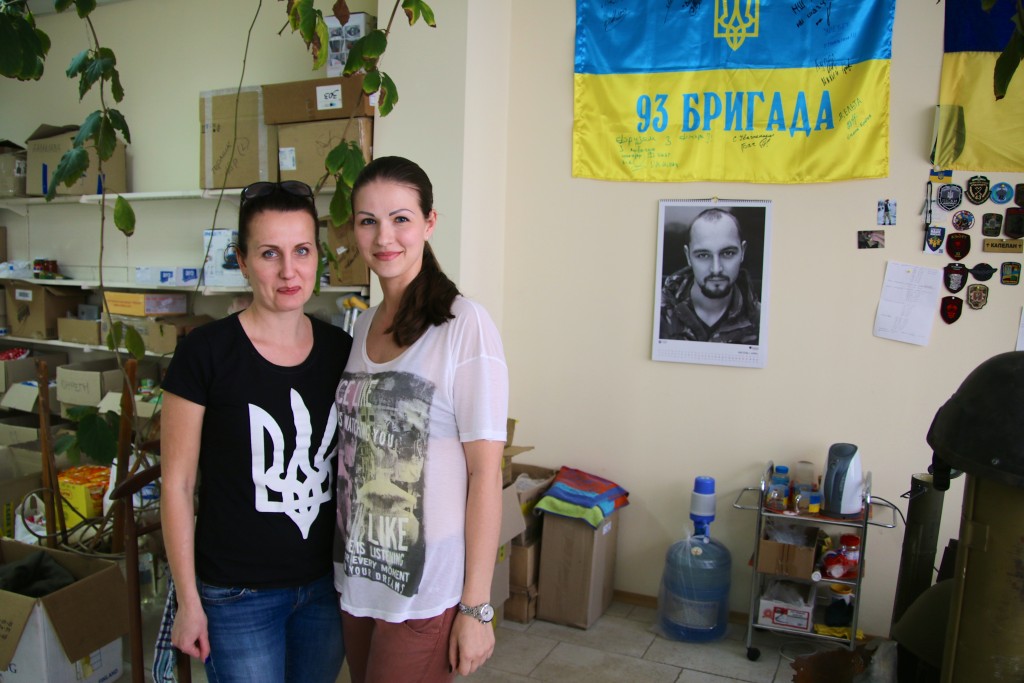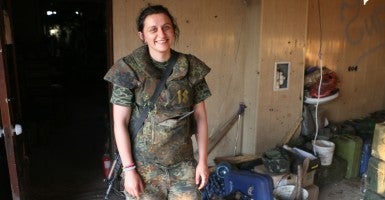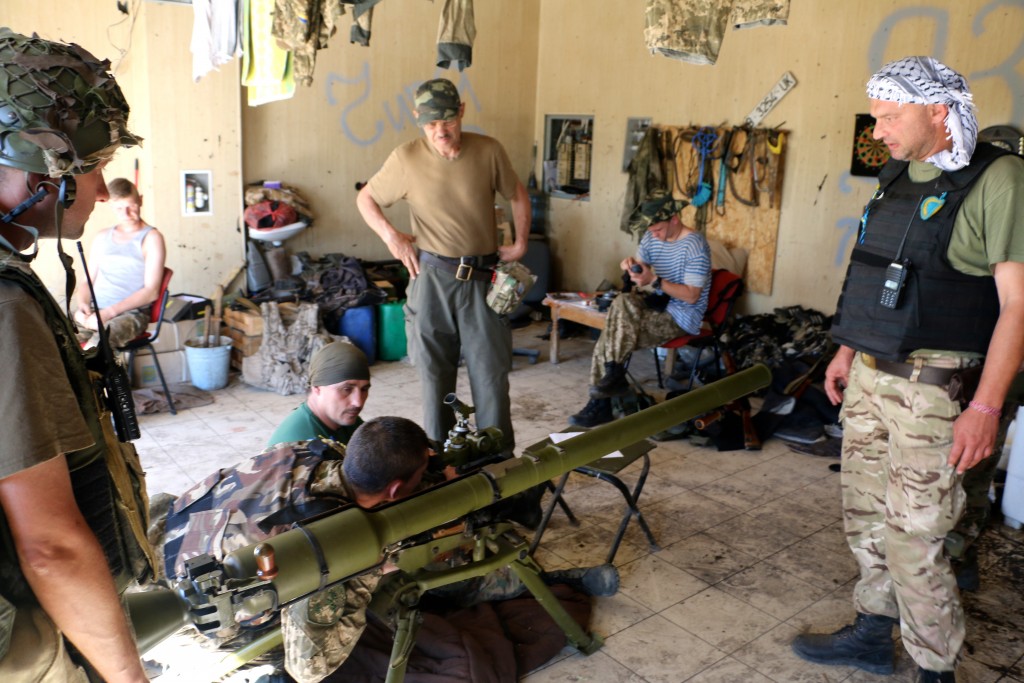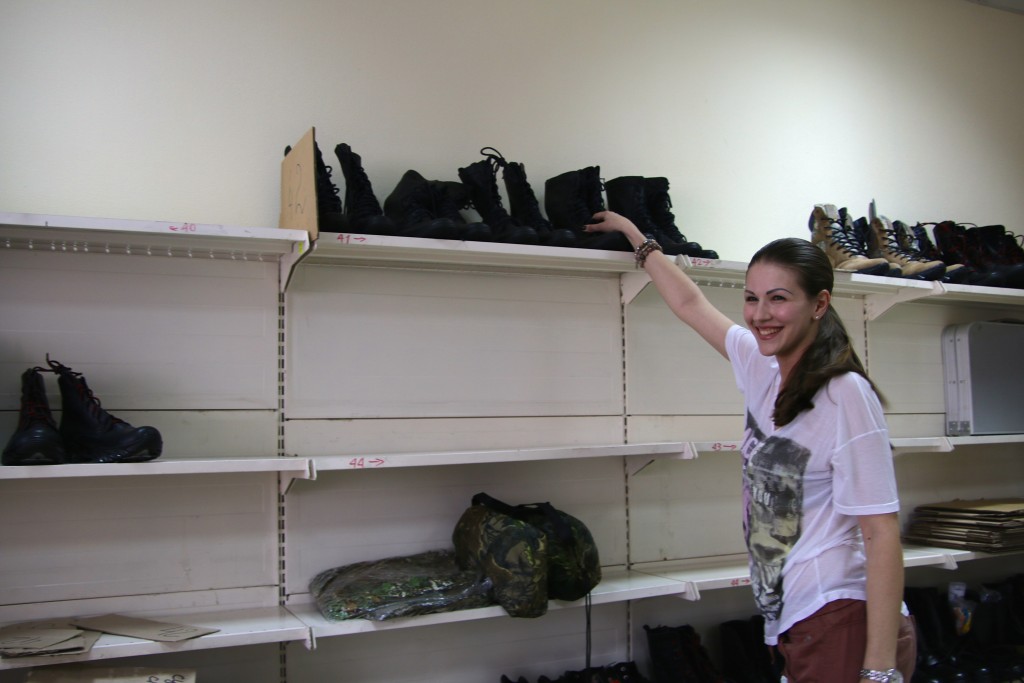KYIV, Ukraine—It was called position 18.
The house, which was yellow and had its roof caved in from artillery hits, was only a hundred meters or so behind the front-line trenches in Pisky, Ukraine.
Shrapnel and bullet holes had shredded the exterior walls, leaving the yellow paint polka-dotted by the grey concrete underneath. The soldiers used the living room as a communal space to eat and sleep.
A generator powered a TV that was playing a women’s boxing match. A couple of soldiers sat on an old leather couch with Kalashnikov assault rifles propped against it, watching silently.
Out in the adjacent garage, which faced away from the trenches and was left open, soldiers were coming and going, grabbing weapons, ammunition, and bottles of water as they shuttled back and forth to the trenches.
The sectional garage door hung from the ceiling, suspended on tracks. A conical divot punctured the front right section, where the door was warped and the metal tracks twisted. A few weeks ago, one of the soldiers explained, a mortar had come through the roof; the suspended garage door trapped the round and stopped it from exploding at ground level.
The unit stationed at position 18 was OUN, a volunteer battalion recently incorporated into the Ukrainian regular army’s 93rd Brigade.
The 93rd Brigade was holding the line several kilometers outside the combined Russian-separatist stronghold of Donetsk. OUN stands for the “Organization of Ukrainian Nationalists,” a partisan group dating back to before World War II.
With the sun settling outside on the late summer afternoon, about a dozen Ukrainian soldiers stood casually inside the garage, talking and joking. They seemed unconcerned by the sounds of artillery and gunfire in the distance.
The soldiers ranged widely in age, some as young as 19, some in their 40s and even 50s. They wore mismatched military uniforms purchased off the Internet, or which civilian volunteers had donated. Some soldiers were cleaning their rifles or tinkering with equipment, while others relaxed, enjoying the relative safety of the garage.
One of the soldiers was a 22-year-old named Julia. She had just returned from the trenches and stood with a Kalashnikov assault rifle slung across her chest as she talked and laughed with the others.
Julia’s dark black hair was pulled back in a bun, but it was a little wild and disheveled. She wore a body armor vest, camouflage pants cut off below the knee, and high black combat boots. Her jewelry was simple—a silver necklace, silver gauge earrings through her earlobes, and a black stud in the upper ear. Two woven bracelets were on her right wrist and a ring on her left index finger.
Julia, whose nom de guerre is “Black,” seemed relaxed. She rolled her eyes and cocked her head in a dismissive laugh when a fellow soldier made a joke about Playboy magazine.
Suddenly, there was the sound of separatist machine gunfire only a hundred meters or so away. Everyone in the garage moved swiftly toward the walls for protection—a few went straight for the door leading into the house.
Julia reacted calmly and purposefully. She barely budged, standing her ground while some of the other soldiers, and this correspondent, scrambled for cover. The smile left her face like a balloon letting out air, and she looked in the direction of the gunfire with a flat, focused expression.
“With regard to her reaction to the fighting, then I would say that she bore them normally and was even more careless than most of the other soldiers,” said Andrey Mikheychenko, an OUN soldier who served with Julia in Pisky.
“As to her personal courage,” Mikheychenko continued, “then, of course, she is very brave—braver than many male soldiers.”
Unofficial Warriors
Since the beginning of the Ukraine war, women have played a key role for Ukraine’s armed forces. They have served on the front lines as infantry, combat medics, and even snipers. And they help sustain the war effort from the home front as civilian volunteers by procuring vital supplies and equipment and delivering them to the front lines.
“I always felt ashamed that I wasn’t in the war when some 18-year-old guys, even if they’re not patriots, have to go,” said Lera Burlakova, 29, who quit her job as a journalist last December to serve as a front-line soldier with the Karpatska Sich volunteer battalion in Pisky.
“If you want to look in the mirror and not turn away, you have to go,” she added. “But I don’t think all people have to do it. Some people are really scared, and that’s the way they are. And maybe they shouldn’t be there, in the war, and die without reason.”
Women are still officially barred from front-line service in Ukraine’s regular army, and most of the women who have served in combat have done so as members of civilian volunteer battalions.
So, as Ukraine continues to rein in the volunteer battalions by integrating them into the regular army or National Guard, new questions are emerging about the future role of female soldiers who have proven themselves in combat and are consequently reluctant to be relegated to support roles behind the lines.
“We have a war, and women are serving,” Burlakova said. “And if a woman wants to be in combat, if she passes the tests, doesn’t break, and has already taken part in the war … then yeah, of course she should be allowed—she shouldn’t have to be a cook.”
A Grassroots War
As Ukraine’s civilian volunteer battalions merged into the Ukrainian National Guard and regular army this year, women serving in combat roles had to officially register for support positions such as cooks or headquarters staff.
Those who wanted to remain in combat roles skirted the rules by registering for non-combat jobs, and then remained on the front lines with their old units, which, despite moving under government control, remained largely intact.
The resulting problem is that there is no official documentation of a female soldier seeing combat, excluding her from awards and benefits.
Due to her unofficial status, for example, Burlakova never received a salary for the five months she spent as a soldier in Pisky. And she is not eligible to receive awards and benefits awarded to male combat veterans, because, as a woman, it was not technically permitted for her to be on the front line.
“You never get official status as someone who was in the war,” Burlakova said. “I’m not sure what the status of combat veteran gives. But I see the guys are so proud of it, and yeah, it would be nice to have it be official.”
According to the Ukrainian Defense Ministry, 67,697 Ukrainian soldiers have been granted “ATO participant status,” indicating combat zone service. This designation entitles certain Social Security benefits as well as free public transportation, first-in-line status for housing and land lots, zero-percent loans for private construction, and a 75-percent discount on public utility service bills.
Government data on the number of women granted ATO participant status was not immediately available, although according to Ukrainian media reports, about 25 percent of Ukraine’s 250,000 military personnel are women.
In 2014, about 100 women were mobilized for military service as part of an emergency program, and the Ministry of Defense announced plans this year to potentially open up the national draft to include women between 20 and 50 years old.
On Equal Footing
Ukraine’s female soldiers serve alongside their male counterparts, enduring the same risks and battlefield living conditions. And while some of the male soldiers demonstrate a protective disposition toward the female soldiers, the women are resistant to special treatment and work to prove themselves as equals.
“Julia faced all the same problems, as everyday problems, physical and mental, as the male fighters,” Mikheychenko said.
“At the same time, the commanders tried in every way to protect her,” he added. “For example, Julia rarely came out on duty in a combat patrol, but she always asked that we put her in, in order to be on an equal footing with everyone else. At the same time, sometimes she was allowed to participate in reconnaissance raids on neutral territory, or even behind enemy lines.”
Burlakova decided to become a soldier after visiting front-line positions while working as a journalist. She attended a military training camp but was initially dissuaded from combat service, thinking it would be too difficult.

Inna Dubniak, 36 (left), and Julia Dimitrova—civilian volunteers at their office in Dnipropetrovsk (Photo: Nolan Peterson/The Daily Signal)
But after visiting Pisky on a five-day journalism assignment and experiencing combat firsthand, Burlakova decided that she was capable of being a soldier.
“I was scared for the first two or three hours, but after that I was OK,” she said. “I saw other women there, and I saw young soldiers learning to shoot out there on the front lines. I realized that I could do it.”
Burlakova called her editor and quit her job. And after a short trip back to Kyiv to arrange her affairs, she returned for five months of combat.
“My dad said I’m an idiot, in a nice way,” she said. “My mom was crying, probably praying.”
Burlakova’s grandfather, who was a pilot in the Soviet air force and currently lives in Moscow, was at first against the idea but ultimately supported his granddaughter’s decision.
“‘You’re a girl and you shouldn’t do it,’ he told me. ‘But if you have to, I understand,’” Burlakova said, recalling her grandfather’s reaction.
Burlakova said she ultimately earned the trust and respect of male comrades by performing well under fire.
“Maybe they [the men] would give you the last piece of candy,” she said. “But they give the women opportunities to prove themselves. It depends on how you act and if you don’t give anyone reasons to treat you differently.”
In some ways, Burlakova explained, it was easier to be a woman on the front lines because there was less of a stigma for a woman to admit fear. “Some men never show their fear,” she said. “I felt allowed to show that I was scared. But you have to be careful so people don’t treat you differently.”
And the fear was real, Burlakova admitted. Yet it was also mixed with exhilaration and a feeling of purpose, sensations that are hard to match in civilian life.
“On the one hand you feel like you really don’t want to die today,” Burlakova said. “And the other hand it’s fun, not really exciting … but you realize how much you want to live.”
Tradition
Ukraine has a historical tradition of women in combat. Women played an active role in the Ukrainian Insurgent Army (the red and black flag of which is a ubiquitous symbol of wartime patriotism in modern Ukraine), which fought a guerrilla war against both Nazi Germany and the Soviet Red Army during World War II.
Ukrainian women also served in the Red Army during World War II, including Russian-Ukrainian sniper Lyudmila Pavlichenko, who was credited with killing 309 German soldiers.
A contemporary example of a Ukrainian woman in combat is Nadiya Savchenko, a 33-year-old Ukrainian combat helicopter navigator who volunteered to serve with the Aidar battalion as a soldier in eastern Ukraine in 2014.
Combined Russian-separatist forces captured Savchenko on June 18, 2014. She was accused of being a spotter during a mortar attack, which Russian authorities claim killed two Russian journalists. She is now being held in Russia after a year in custody in Donetsk and faces up to 25 years in prison.
On March 2, 2015, Ukrainian President Petro Poroshenko awarded Savchenko the title “Hero of Ukraine”—the nation’s highest military honor.
“Nadiya Savchenko is a symbol of the struggle for Ukraine,” Poroshenko said in a July 2 statement. “While in captivity she has demonstrated the true, strong, martial Ukrainian spirit of a serviceman who doesn’t betray the motherland.”
Total War
While the Ukraine war affects only a small portion of the country geographically, Ukrainian society has mobilized across all spectrums to sustain the war effort.
After a year and a half, the war is still a grassroots effort, sustained by civilian volunteers who, often with no military background or training, raise money to buy supplies for Ukrainian soldiers and then deliver those supplies to the front lines.
The volunteer movement is essential to Ukraine’s war effort, and many combat units are still dependent on civilian volunteers for basic necessities—including uniforms, food, water, first aid kits, body armor, and medical supplies.
Ukrainian women play a key role in the volunteer movement.
“I just can’t step aside and look away,” said Julia Minaeva, a 26-year-old university instructor in Kyiv. Minaeva collects supplies, including letters from children, for deployed troops, and she visits the wounded in hospitals, speaking to them about “anything but the war” to raise their spirits.
“Every day when I go to sleep, I had a peaceful day because of the soldiers,” Minaeva said. “They’re sleeping in trenches and in block posts, and they’re giving us the opportunity to live peacefully. It’s our duty to help them, and I feel like I need to do something for our country.”
Minaeva says wounded soldiers are often in need of conversation with people outside their families—and to not talk about the war.
“They’re still men,” she said. “They’re still clever and handsome, even if they don’t have an arm, or a leg. They’re really great people. They never complain. They just want to get back on their feet and get back out there to protect us.”
That’s War
Julia Dimitrova, 28, is a civilian volunteer in Dnipropetrovsk. The mother of two sons (4 and 2 years old) lived in Donetsk for 14 years and still has many friends there, including some who have taken up arms with the combined Russian-separatist forces.
“It’s very difficult that I live here and realize that I help the soldiers that kill my friends,” she said. “But that’s life. That’s war.”
In July 2014, Dimitrova and four other women started a grassroots supply drive to gather equipment for Ukrainian soldiers. They raise money on Facebook to buy supplies like boots and first aid kits, and, about once a week, Dimitrova travels to the front lines to deliver what she has collected.
“It’s not really good out there; our guys need a lot of support,” she said. “Our country wasn’t ready for a war. Not a year ago, not now.”
Dimitrova said she rarely wears body armor when she travels to the front, even though she faces the same risks of artillery and sniper fire as the soldiers to whom she is delivering supplies. She also said there are separatist diversion groups, which try to intercept civilian supply runs—sometimes kidnapping or murdering the volunteers.
“My family thinks I’m crazy,” Dimitrova said. “A year ago, my husband wanted a divorce, but he got used to it.”
Dimitrova works in a rented office in downtown Dnipropetrovsk. The walls are lined with various supplies and memorabilia from the war zone. Like many civilian volunteers, Dimitrova had no prior military experience before deciding to support the war effort. She used to do a little modeling and was a housewife before the war started. But, echoing a common refrain among Ukraine’s volunteers, she said she couldn’t sit idly by while others fought.
“I saw that I could do this, and I could do it well,” Dimitrova said. “And now the volunteers are like a second family for me. I know that if we met in normal life, we’d never get together. But this experience has bonded us.”
The war also takes a psychological toll on the civilian volunteers, who are firsthand witnesses to the suffering of the soldiers.
“It’s something you never get used to,” Minaeva said, fighting back tears as she spoke about a soldier she knew who was killed. “It’s a war and this is what we have to do. I have no right to complain.”
“I always cry when there’s a funeral,” Dimitrova said. “War never has a happy end.”
An Unfinished Fight
Julia entered service on the front lines in Pisky in April 2015, and was pulled off the lines after being wounded in July. She is currently an instructor at OUN’s training camp outside Kyiv.
Mikheychenko praised Julia’s courage under fire and her skills as a soldier, which he witnessed firsthand, but he also retains some misgivings about women serving in combat.
“In general, I personally think that in war, women should not be in combat,” Mikheychenko said. “It is hard to see how they are injured or killed.”
“On the other hand,” he added, “they mobilize men by their brave behavior and give them courage. These men are too embarrassed to show cowardice because some women do not stop.”
Burlakova, who is currently back at work as a journalist, said she plans to return to the front lines in September.
“The main problem is you want to go back,” Burlakova said, explaining what it was like to return to Kyiv after her time in combat. “You make better friends in the war than in real life. … As a soldier it’s easier sometimes. You just stand there with weapons and fight; it’s simple. In some way, being a soldier is an escape. Kyiv is more difficult and depressing.”
Minaeva expects that the work of caring for soldiers and their families will last long after the war has ended. “When the war ends, I will give myself two days to sleep, and then there are a lot of things to do to help these families, and to help the soldiers,” she said.
“Most of all,” Minaeva added, “I want every soldier to get back with victory, alive and healthy.”































